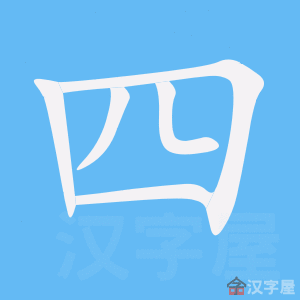Character
| HSK | 1 |
|---|---|
| FREQUENCY | 226th character |
| RADICAL | ⼞ (31.2) |
| STROKES | 5 |
| INDEX # | 262 |
four
HSK 1
#226
DEFINITIONS
- four
- four
- 4
STROKES


WORDS
| 四出文钱 sì chū wén qián | coin minted in the reign of Emperor Ling of Han 漢靈帝|汉灵帝[Han4 Ling2 Di4], with a square hole in the middle and four lines radiating out from each corner of the square (hence the name 四出文) |
| 四出文錢 sì chū wén qián | coin minted in the reign of Emperor Ling of Han 漢靈帝|汉灵帝[Han4 Ling2 Di4], with a square hole in the middle and four lines radiating out from each corner of the square (hence the name 四出文) |
| 四分五裂 sì fēn wǔ liè | all split up and in pieces (idiom); disunity (in an organization); complete lack of unity; to disintegrate; falling apart; to be at sixes and sevens |
| 四分历 sì fēn lì | "quarter remainder" calendar, the first calculated Chinese calendar, dating from c. 484 BC |
| 四分曆 sì fēn lì | "quarter remainder" calendar, the first calculated Chinese calendar, dating from c. 484 BC |
| 四分卫 sì fēn wèi | quarterback (QB) (American football) |
| 四分衛 sì fēn wèi | quarterback (QB) (American football) |
| 四分音符 sì fēn yīn fú | crotchet (music) |
| 四化 sì huà | abbr. for 四個現代化|四个现代化[si4 ge4 xian4 dai4 hua4], Deng Xiaoping's four modernizations |
| 四十二章经 sì shí èr zhāng jīng | The Sutra in Forty-two Sections Spoken by the Buddha, the first Chinese Buddhist text, translated in 67 by Kasyapa-Matanga 迦葉摩騰 and Gobharana 竺法蘭 (Dharmaraksha) |
| 四十二章經 sì shí èr zhāng jīng | The Sutra in Forty-two Sections Spoken by the Buddha, the first Chinese Buddhist text, translated in 67 by Kasyapa-Matanga 迦葉摩騰 and Gobharana 竺法蘭 (Dharmaraksha) |
| 四国 sì guó | Shikoku (one of the four main islands of Japan) |
| 四國 sì guó | Shikoku (one of the four main islands of Japan) |
| 四国犬 sì guó quǎn | Shikoku (dog) |
| 四國犬 sì guó quǎn | Shikoku (dog) |
| 四围 sì wéi | all around; on all sides; encircled |
| 四圍 sì wéi | all around; on all sides; encircled |
| 四境 sì jìng | all the borders |
| 四壁萧然 sì bì xiāo rán | four bare walls |
| 四壁蕭然 sì bì xiāo rán | four bare walls |
| 四大佛教名山 sì dà fó jiào míng shān | Four Sacred Mountains of Buddhism, namely: Mt Wutai 五臺山|五台山 in Shanxi, Mt Emei 峨眉山 in Sichuan, Mt Jiuhua 九華山|九华山 in Anhui, Mt Potala 普陀山 in Zhejiang |
| 四大名著 sì dà míng zhù | the Four Classic Novels of Chinese literature, namely: A Dream of Red Mansions 紅樓夢|红楼梦[Hong2 lou2 Meng4], Romance of Three Kingdoms 三國演義|三国演义[San1 guo2 Yan3 yi4], Water Margin 水滸傳|水浒传[Shui3 hu3 Zhuan4], Journey to the West 西遊記|西游记[Xi1 you2 Ji4] |
| 四大天王 sì dà tiān wáng | the four heavenly kings (Sanskrit vajra); the four guardians or warrior attendants of Buddha |
| 四大发明 sì dà fā míng | the four great Chinese inventions: paper, printing, magnetic compass and gunpowder |
| 四大發明 sì dà fā míng | the four great Chinese inventions: paper, printing, magnetic compass and gunpowder |